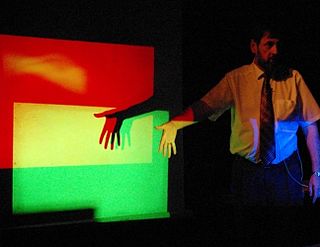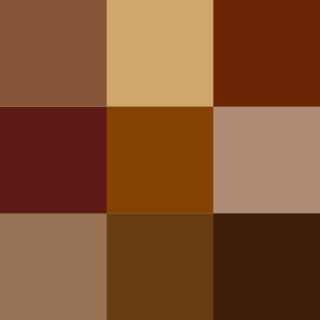
Brown is a color. It can be considered a composite color, but it is mainly a darker shade of orange. In the CMYK color model used in printing or painting, brown is usually made by combining the colors orange and black. In the RGB color model used to project colors onto television screens and computer monitors, brown combines red and green.

Pleochroism is an optical phenomenon in which a substance has different colors when observed at different angles, especially with polarized light.
In computing, on the X Window System, X11 color names are represented in a simple text file, which maps certain strings to RGB color values. It was traditionally shipped with every X11 installation, hence the name, and is usually located in <X11root>/lib/X11/rgb.txt. The web colors list is descended from it but differs for certain color names.

The western yellow wagtail is a small passerine in the wagtail family Motacillidae, which also includes the pipits and longclaws.

The yellow-legged gull is a large gull found in Europe, the Middle East and North Africa, which has only recently achieved wide recognition as a distinct species. It was formerly treated as a subspecies of either the Caspian gull L. cachinnans, or more broadly as a subspecies of the herring gull L. argentatus. The genus name is from Latin Larus which appears to have referred to a gull or other large seabird, and the species name honours the German zoologist Karl Michahelles.

Complementary colors are pairs of colors which, when combined or mixed, cancel each other out by producing a grayscale color like white or black. When placed next to each other, they create the strongest contrast for those two colors. Complementary colors may also be called "opposite colors".

The Flag of Ukraine consists of equally sized horizontal bands of blue and yellow. As a national flag, the blue and yellow bicolour has been used since the 1848 Spring of Nations, when it was hoisted over Lviv Town Hall. It was officially adopted as a state flag for the first time in 1918 by the short-lived West Ukrainian People's Republic and subsequently used by the Ukrainian People's Republic, just before World War II it was also adopted by Carpatho-Ukraine in March 1939.

A color term is a word or phrase that refers to a specific color. The color term may refer to human perception of that color which is usually defined according to the Munsell color system, or to an underlying physical property. There are also numerical systems of color specification, referred to as color spaces.

Powerade is a sports drink created, manufactured and marketed by The Coca-Cola Company. Its primary competitor is Gatorade, owned by PepsiCo.

The yellow-bellied marmot, also known as the rock chuck, is a large, stout-bodied ground squirrel in the marmot genus. It is one of fourteen species of marmots, and is native to mountainous regions of southwestern Canada and western United States, including the Rocky Mountains, Sierra Nevada, and Mount Rainier in the state of Washington, typically living above 2,000 metres. The fur is mainly brown, with a dark bushy tail, yellow chest and white patch between the eyes, and they weigh up to approximately 5 kilograms. They live in burrows in colonies of up to twenty individuals with a single dominant male. They are diurnal and feed on plant material, insects, and bird eggs. They hibernate for approximately eight months starting in September and lasting through the winter.
In many languages, the colors described in English as "blue" and "green" are colexified, i.e. expressed using a single cover term. To describe this English lexical gap, linguists use the portmanteau word grue, from green and blue, a term coined by the philosopher Nelson Goodman—with a rather different meaning—in his 1955 Fact, Fiction, and Forecast to illustrate his "new riddle of induction".

The flag of the United States Navy consists of the seal of the U.S. Department of the Navy in the center, above a yellow scroll inscribed "United States Navy" in dark blue letters, against a dark blue background.

Wilmington Grammar School for Boys (WGSB) is a grammar school with academy status in Wilmington, Kent.
Bomberman B-Daman Bakugaiden, commonly abbreviated as BB-Daman Bakugaiden (Bビーダマン爆外伝) or BBB, is a CoroCoro Comic series created by Koichi Mikata, based on Bomberman and B-Daman. An animated television series was created and originally broadcast on Nagoya TV and TV Asahi at 17:00. It was also broadcast internationally on Taiwan Television (Taiwan), TVB Jade, GMA Network (Philippines), RCTI, Spacetoon (Indonesia), QTV 11 (Philippines) and Hero TV (Philippines), Jetix.

The Caspian turtle or striped-neck terrapin is a species of turtle in the family Geoemydidae (=Bataguridae), living in the eastern Mediterranean region from southwestern former USSR and central Iran to Saudi Arabia, Bahrain, Israel, and Lebanon, northward through Turkey to Bulgaria, and through Cyprus, Crete, and the Ionian Peninsula to former Yugoslavia.

The satinbirds or cnemophilines, are a family, Cnemophilidae of passerine birds which consists of four species found in the mountain forests of New Guinea. They were originally thought to be part of the birds-of-paradise family Paradisaeidae until genetic research suggested that the birds are not closely related to birds-of-paradise at all and are perhaps closer to berry peckers and longbills (Melanocharitidae). The current evidence suggests that their closest relatives may be the cuckoo-shrikes (Campephagidae).

There are three types of color mixing: additive, subtractive, and average. In first two cases, mixing is typically described in terms of three primary colors and three secondary colors. Subtractive mixing with all three primaries will result in black, while additive mixing with all three primaries will result in white.
Colours of the Syrian hamster can be described in three ways: as "self", "agouti" or "combinations". Self colours are a consistent coat colour with the same colour topcoat and undercoat. Agouti hamsters have a different, lighter undercoat and markings around the eyes. Combinations are produced when two self or agouti colours are present.

Shades of brown can be produced by combining red, yellow, and black pigments, or by a combination of orange and black—illustrated in the color box. The RGB color model, that generates all colors on computer and television screens, makes brown by combining red and green light at different intensities. Brown color names are often imprecise, and some shades, such as beige, can refer to lighter rather than darker shades of yellow and red. Such colors are less saturated than colors perceived to be orange. Browns are usually described as light or dark, reddish, yellowish, or gray-brown. There are no standardized names for shades of brown; the same shade may have different names on different color lists, and sometimes one name can refer to several very different colors. The X11 color list of web colors has seventeen different shades of brown, but the complete list of browns is much longer.













